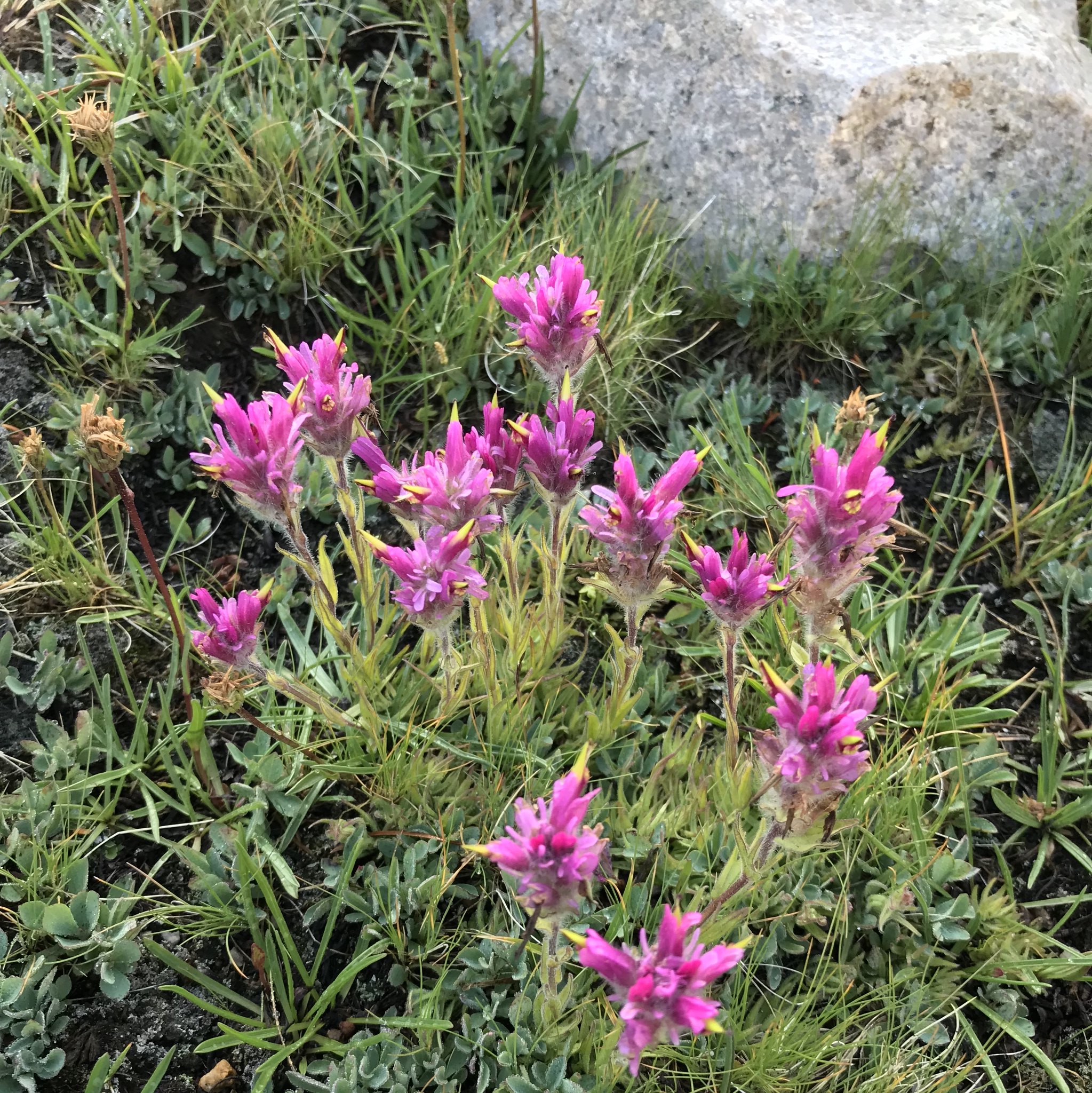grampy writes:
I really appreciate the naturalist elements - especially the flower identification- and your sensitivity to not disturbing nesting sites. Great that you get to bring your doggo friends. And the sunrise profile of Wolfie - he looks so noble !
giantbrookie decided not to castigate me for my sins divulging lakes with small, edible fish. He also commented favorably on the flower shots, so I'll include a few more of those, and add a couple of favorite dog pics for grampy. I appreciate the interest, and the comments, thanks.
Another Red Mountain Heather (I like to add the name "Mountain" wherever I can). This mat-forming species must be the dominant flower throughout most of the Sierra tree-line zone, is there any competition?
A giant little dog, Wolfie is!
Due to the interest in Natural History, I'll add some of the notes I culled from the TR, and D & C's comprehensive Bird list:
NATURAL HISTORY
This is the nest and scat pile of a Western heather vole, genus
Phenocomys. The Heather vole does not hibernate. In the winter, the vole builds its nest on the surface of the ground under the snow. These small rodents keep active all winter long, eating stored food like the Pika do. They build their winter nest right on the surface, under the snow. They have a tunnel to defecate in, just by the nest. This is why we are pretty sure this is Heather Vole scat and nesting material. The scat was originally found in a tight, cylindrical shape, before I began examining it. This is the shape you'd expect if it were deposited into a tunnel. The tight grass nest material fits the description too.
Note the cylinder composed of many thousands of little scats.
So many color variations here growing side by side. I just clarified something I have always wondered about Columbine: "The genus name
Aquilegia is derived from the Latin word for eagle (aquila), because of the shape of the flower petals, which are said to resemble an eagle's claw."
The most common color of Paintbrush flowers, probably
C. miniata.
This is the Wyoming paintbrush, or Narrow-leaved paintbrush,
C. linariifolia, which we found growing in its lovely pink variant, all along the Pine Cr. trail up to the Brownstone mine, and even above. I looked it up, and read this about it: "... while the species is widespread in the western US, this unusual color form is endemic to the east slope of the central California Sierra Nevada." It is Wyoming's State flower too. I'm not sure that I have ever seen this light pink form anywhere else. Note that it's not to be confused with another somewhat rare, pink colored paintbrush flower, which usually grows up in the high meadows; that one is
C. lemmonii, and it is usually a darker pink.
This neat little fern was familiar to me, but I'd never read up on it. Here is what I found:
PARSLEY FERN,
Cryptogramma crispa var.
acrostichoides
Plants 2 to 9 inches high, the fertile fronds taller than the sterile ones. On sterile branches a narrow wing follows from the flat pinna
down the stalk, the wing usually absent in the fertile stalk, or scarcely winged.
American Rock Brake is another common name for this species. Distributed from 5,000 to 10,000 feet elevation, more common in the
higher elevations, in cracks of granite rock. Known from Alaska, Labrador, around the Great Lakes, and in Nebraska and New Mexico.
It may be observed above Tenaya Lake, along trails leading out of Tuolumne Meadows and on Sentinel Dome in Yosemite.
Diana and Carleton's Bird List:
[Diana writes: "Here's our trip list! Let me know what I forgot or got wrong! Am I remembering we had Common Nighthawks somewhere - or possibly we had them at Mono Lake? I didn't write it down. We had a couple new species (MacGillivray's Warbler, Red-breasted - not Williamson's! - Sapsucker) on our hike out without you.]
1. Mallard
2. Red-tailed Hawk
3. Peregrine Falcon
4. Gull spp.
5. Spotted Sandpiper
6. White-throated Swift
7. Rufous Hummingbird
8. Hairy Woodpecker
9. Red-breasted Sapsucker
10. Red-shafted Flicker
11. White-headed Woodpecker
12. Mourning Dove
13. Olive-sided Flycatcher
14. Western Wood-Pewee
15. Pacific-slope Flycatcher
16. Dusky Flycatcher
17. Warbling Vireo
18. Swallow spp. (Tree or Violet-green)
19. Steller’s Jay
20. Clark’s Nutcracker
21. Common Raven
22. Horned Lark
23. American Pipit
24. Mountain Chickadee
25. House Wren
26. Rock Wren
27. Golden-crowned Kinglet
28. Ruby-crowned Kinglet
29. Mountain Bluebird
30. American Robin
31. Hermit Thrush
32. Townsend’s Solitaire
33. Nashville Warbler
34. Wilson’s Warbler
35. Audubon’s (Yellow-rumped) Warbler
36. MacGillivray’s Warbler
37. Hermit Warbler
38. Western Tanager
39. Spotted Towhee
40. Green-tailed Towhee
41. Chipping Sparrow
42. Song Sparrow
43. (Mountain) White-crowned Sparrow
44. Dark-eyed (Oregon) Junco)
45. Gray-crowned Rosy-Finch
46. Cassin’s Finch

